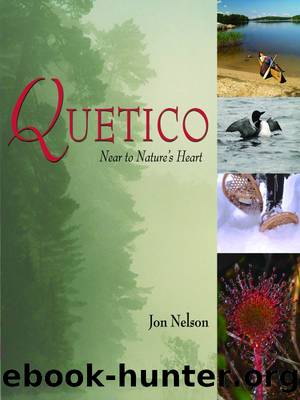Quetico by Nelson Jon

Author:Nelson, Jon
Language: eng
Format: epub
Tags: NAT000000, book
Publisher: Dundurn Press
Published: 2009-05-20T04:00:00+00:00
Indian Pipe, lacking chlorophyll, obtains its energy from its association with the roots of other plants.
The rounded seed pod of a twinflower has spines that attach to the fur of small mammals.
In some instances, commensalism can be hard to distinguish from mutualism since relationships between different species are often not well enough understood to be certain that only one species is benefiting from the relationship. Many naturalists, trappers, and ecologists have commented on the special relationship that exists between wolves and ravens. Wolves not only kill their prey, but they also open the body cavities so that ravens, turkey vultures, and other scavengers are able to feed on what is left behind. Other animals, not usually considered scavengers, such as mink, pine marten, and whisky jacks will also take advantage of these carcasses, especially in the winter when food is scarce. Many biologists feel that this is commensalism since ravens and other scavengers clearly profit by eating wolf kills, while wolves don’t seem to benefit from the relationship with the scavengers.
Other observers, however, believe ravens provide wolves with clues that prey are in the vicinity and signal their location by circling over them and calling loudly. If this is the case, then wolves are also profiting from the relationship with ravens and their interaction should be regarded as mutualism. Berndt Heinrich’s observations led him to note that ravens and wolves work together so closely that maybe ravens “had evolved with wolves in a mutualism that is millions of years old, so that they have innate behaviors that link them to wolves, making them uncomfortable without their presence.”2
MUTUALISM
In many cases of mutualism a plant is aided in reproduction by an animal seeking food. The hummingbird and honeybee obtain nector or pollen while they inadvertently spread the pollen from one flower to another. Red squirrels feed on the seeds in pine cones and the nuts of the beaked hazel. They also scatter them far from the parent plant by placing them in caches and sometimes forgetting about them. These relationships that spread pollen and seeds far from the parent plant greatly impact the ecology of the Quetico-Superior landscape, but other examples of mutualism are at least as significant even though they are far more subtle.
Download
This site does not store any files on its server. We only index and link to content provided by other sites. Please contact the content providers to delete copyright contents if any and email us, we'll remove relevant links or contents immediately.
The Lonely City by Olivia Laing(4768)
Animal Frequency by Melissa Alvarez(4424)
All Creatures Great and Small by James Herriot(4266)
Walking by Henry David Thoreau(3921)
Exit West by Mohsin Hamid(3791)
Origin Story: A Big History of Everything by David Christian(3665)
COSMOS by Carl Sagan(3584)
How to Read Water: Clues and Patterns from Puddles to the Sea (Natural Navigation) by Tristan Gooley(3430)
Hedgerow by John Wright(3313)
How to Read Nature by Tristan Gooley(3289)
The Inner Life of Animals by Peter Wohlleben(3282)
How to Do Nothing by Jenny Odell(3263)
Project Animal Farm: An Accidental Journey into the Secret World of Farming and the Truth About Our Food by Sonia Faruqi(3188)
Origin Story by David Christian(3168)
Water by Ian Miller(3153)
A Forest Journey by John Perlin(3042)
The Plant Messiah by Carlos Magdalena(2899)
A Wilder Time by William E. Glassley(2832)
Forests: A Very Short Introduction by Jaboury Ghazoul(2814)
